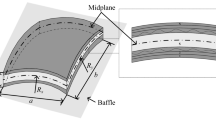Abstract
Purpose
To investigate the effects of the temperature distribution and the change of the boundary condition on vibration response of the panel under combined thermal–acoustic loads.
Methods
Both thermal–acoustic tests and numerical simulation were carried out on a titanium flat plate. Two methods are used to equivalent the change of the testing boundary condition. One is using spring to replace the freedom. Another way is adding the force in that direction.
Results
The results show that when the boundary condition is ideally fixed, with the increase of the temperature, the trends of the modal frequencies for uniform and non-uniform temperatures are almost the same. As the increase of the temperature, the first modal frequency is reduced to zero before the critical buckling temperature, and then, the frequency will be increased. The temperature distribution will affect the critical buckling temperature. For the different boundary condition, the results show that, with the reduction of the spring stiffness, the critical buckling temperature is increased, and the trends of the modal frequencies are similar. However, with the increase of the in plane force, the modal frequencies will reduce.
Conclusions
The results show that the temperature distribution has a little effect on the modal parameters. Compared with the temperature distribution, the boundary condition has much more influence. Therefore, much care needs to be taken to design the fixture during thermal–acoustic tests.
















Similar content being viewed by others
References
Blevins RD, Holehouse I, Wentz KR (1993) Thermoacoustic loads and fatigue of hypersonic vehicle skin panels. J Aircr 30(6):971–978
Dhainaut JM, Guo X, Mei C, Spottswood SM, Wolfe HF (2003) Nonlinear random response of panels in an elevated thermal-acoustic environment. J Aircr 40(4):683–691
Yang Y, Wu CW (2016) Coupling analysis for the thermo-acoustic-vibration response of a thin-walled box with acoustic excitations. J Vib Eng Technol 4(5):423–429
Caughey TK (1963) Derivation and application of the FPK equation to discrete nonlinear dynamic systems to white random excitation. J Acoust Soc Am 35(11):1683–1692
Crandall SH (1963) Perturbation techniques for random vibration of nonlinear systems. J Acoust Soc Am 35(11):1700–1705
Caughey TK (1963) Equivalent linearization techniques. J Acoust Soc Am 35(11):1706–1711
Shinozuka M, Jan DM (1972) Digital simulation of random processes and its applications. J Sound Vib 25:111–128
Kicinski J (2014) New method of analysis of nonlinear stochastic and random vibrations. J Vib Eng Technol 2(5):407–414
Locke JE, Mei C (1990) A finite element formulation for the large deflection random response of thermally buckled beams. AIAA J 28:2125–2131
Dhainaut JM, Mei C (2006) Nonlinear response and fatigue life of isotropic panels subjected to nonwhite noise. J Aircr 43(4):975–979
Behnke MN, Sharma A, Przekop A, Rizzi SA (2010) Thermal-acoustic analysis of a metallic integrated thermal protection system structure, 51st AIAA/ASME/ASCE/AHS/ASC Structures. In: Structural Dynamics, and Materials Conference, Orlando
Hollkamp JJ, Gordon RW (2010) Coupling acoustic modal models to nonlinear structural reduced-order models. In: 51st AIAA/ASME/ASCE/AHS/ASC structures, structural dynamics, and materials conference, Orlando
Mignolet MP, Przekop A, Rizzi SA, Spottswood SM (2013) A review of indirect/non-intrusive reduced order modeling of nonlinear geometric structures. J Sound Vib 332:2437–2460
Liguore SL, Pitt DM, Thomas MJ, Gurtowski NL (2013) Thermal acoustic test and analysis model updating and correlation. In: 54th AIAA/ASME/ASCE/AHS/ASC structures, structural dynamics, and materials conference, Boston
Rizzi SA, Przekop A (2008) System identification-guided basis selection for reduced-order nonlinear response analysis. J Sound Vib 315:467–485
Jeyaraj P, Padmanabhan C, Ganesan N (2008) Vibration and acoustic response of an isotropic plate in a thermal environment. J Vib Acoust 130:051005-1-6
Jeyaraj P, Ganesan N, Padmanabhan C (2009) Vibration and acoustic response of a composite plate with inherent material damping in a thermal environment. J Sound Vib 320:322–338
Rizzi SA, Turner TL (1997) Enhanced capabilities of the NASA Langley thermal acoustic fatigue apparatus. In: Proceedings of the 6th international conference on recent advances in structural dynamics vol. II, Ed Ferguson Wolfe Mei, pp 919–933
Rizzi SA, Bossaert G (2001) Closed-loop control for sonic fatigue testing systems. Sound Vib 35(11):1–11
Pearson J (1994) High-temperature acoustic test facilities and methods. In: Symposium on impact of acoustic loads on aircraft structures, Norway
Jacobs JH, Gruensfelder C, Hedgecock CE (1993) Thermal-acoustic faigue of ceramic matrix composite materials. In: 34thAIAA/ASME/ASCE/AHS/ASC structures, structural dynamics, and materials conference, La Jolla, CA
Bayerdöerfer G, Freyberg L (1996) Thermoacoustic tests to qualify TPS-Design. In: Proc. Conference on Spacecraft Strictires, Materials & Mechanical Testing, Noordwijk, The Netherlands
Cheng H, Li HB, Zhang W, Wu ZQ, Liu BR (2015) Effects of radiation heating on modal characteristics of panel structures. J Spacecr Rockets 52(4):1228–1235
Author information
Authors and Affiliations
Corresponding author
Rights and permissions
About this article
Cite this article
Li, P., Xu, Y.T. Effect of Boundary Condition on Dynamic Response During Thermal–Acoustic Test. J. Vib. Eng. Technol. 7, 33–42 (2019). https://doi.org/10.1007/s42417-018-0074-8
Received:
Accepted:
Published:
Issue Date:
DOI: https://doi.org/10.1007/s42417-018-0074-8




